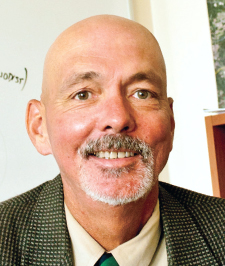A Modern-Day Gold Rush
The promise of a better education and better quality of life for thousands of South Texans

The Eagle Ford Shale is rapidly transforming the quality of life in once-declining rural communities in South Texas. The hydrocarbon-producing formation generated $25 billion in total economic output last year in an area stretching from Maverick County to the southwest of San Antonio up to Gonzales County to the east.
“This is a very quickly evolving business story,” Robert McKinley, director of the UTSA Institute for Economic Development (IED), told several hundred South Texas business owners, oil and natural gas producers, elected officials and other Eagle Ford Shale stakeholders on May 9, 2012, when announcing the results of an IED Center for Community and Business Research (CCBR) economic impact study of the Eagle Ford Shale. “If you look at this last year, 2010 and 2011, natural gas production doubled. If you look at the same time period, oil production was six times greater. If you look at permitting activity, rate of completions, it was a quickly moving story.” Texas Speaker of the House of Representatives Joe Straus said the oil and natural gas drilling in the Eagle Ford Shale “ultimately means less reliance on foreign sources of energy.” UTSA President Ricardo Romo chuckled that, with 5,000 acres of land in the Eagle Ford area and one oil well producing $100,000 a week, “UTSA is in the oil business.”
San Antonio Mayor Julián Castro declared that the impact is not just economic. It promises a better education and better quality of life for thousands of South Texans, and this means greater prosperity for all of Texas in the coming decades. The lofty declarations reflected the heights that dollar figures and oil and natural gas production reached in the Eagle Ford area last year. Thomas Tunstall, director of CCBR, delivered these numbers from the study: Last year 1,015 new wells were put into play— more than double the 408 new wells CCBR had predicted for the year 2011 in its first economic impact study, dated February 2011. The Eagle Ford Shale (EFS) generated $25 billion in total economic output last year, $3 million more than they had predicted by the year 2020. EFS supported 46,097 full-time jobs and generated $257 million in local government revenues and $358 million in state revenues. America’s Natural Gas Alliance, which represents 30 of North America’s largest independent natural gas exploration and production companies, supported UTSA’s CCBR studies, published February 2011 and May 2012.
At the meeting in May, business owners in the region described the challenges associated with doubling or tripling business growth and finding good workers to fill their labor needs, as well as quickly deteriorating roads and other problems. “Our focus has been on sustainability—how are we going to be impacted economically, workwise,” said Leodoro Martinez, chairman of the Eagle Ford Consortium and executive director of the Middle Rio Grande Development Council. “We all want to find out how long this is going to last.”
Energy booms and the sudden rush of questions that come along with the fleets of big rigs, camper trailers and international oil executives with large quantities of cash are nothing new to the state of Texas. Texans have more than a century of oil booms and busts marking their state’s history. They know that all good things can and do come to an end. So, even though the deep and rich Eagle Ford Shale is only 6 percent into its natural gas and oil play, residents and other stakeholders have increasingly turned to UTSA for answers to their questions.
“It’s such a huge opportunity for South Texas rural communities,” said Gilbert Gonzalez, director of the UTSA Small Business Development Center’s Rural Business Program. “Leaders are trying to find ways to convert the challenges to opportunities during the boom by managing the windfall coming to their communities. In order to create sustainability in the oil and impacted region, they need to develop medium- to long-term plans that outline their priorities and investment strategies for infrastructure, residential and commercial development, workforce development, social services and transportation needs. If they have the capability to plan and invest in their future, they can create sustainability and quality jobs for that area.”
The Rural Business Program opened an office in Carrizo Springs in November 2011 to provide assistance to business owners and community officials living and working in the Eagle Ford area. “The need for small business development services has more than doubled since EFS came into play,” Gonzalez said. “We thought this would be a way to augment services and support staff because it’s happening so fast.” Representing UTSA, Gonzalez is part of the Eagle Ford Consortium, which coordinates discussions around workforce, community and economic development of the 24 counties that make up the Eagle Ford area. He visited the Bakken formation in North Dakota, where energy explorers began hydraulic fracturing two years ahead of the Eagle Ford Shale, to learn about the issues that stakeholders there faced and how they responded to them.
Azza Kamal, a senior lecturer in the UTSA College of Architecture, saw how community leaders were struggling with the challenge of displaced residents who are now homeless. “Rental prices are increasing because of the greater demand from incoming workers,” Kamal said. “So now the people who benefited from Section 8 voucher programs cannot find housing they can afford. That’s forcing them to move in with friends or just be on the street.” She presented a study to the Eagle Ford Consortium in February 2012 showing that the population of the six counties in the EFS area will reach as many as 86,297 people from 2010 to 2025. Some of those people will be transient workers, but others will be permanent workers. To address homelessness and the greater demand for permanent, semipermanent and temporary housing, Kamal’s report made suggestions for landowners and local officials: Develop home repair and rehabilitation programs to fix currently vacant housing units to help meet demand. Use family-oriented planning patterns, including open spaces and green spaces, for all types of housing developments, including crew camps. And while some can profit from building permanent multifamily and single family homes, at the beginning there will be a greater need for semipermanent residential developments, such as mobile home parks, to accommodate the workers who have homes in other communities.
Workers are filling up apartment buildings, hotels and motels, and renting rooms and garage apartments, as well as living in haphazardly arranged trailers and campers. “This is a major problem,” Kamal said. “This is a huge burden on the infrastructure, on services, grocery stores and schools. It’s an undesirable way to grow a town.”
Tunstall said by studying the events and issues in other oil and gas plays throughout history and analyzing the situation and resources in the Eagle Ford area, UTSA can help local officials and business owners avoid mistakes made in years past. “With all of these changes, communities are being tested. An encouraging sign we see is that communities are attempting to employ revenue and investment strategies that look farther into the future than perhaps leaders have been used to doing. This will require good governance and good management, an engaged citizenry, fiscal discipline and a workforce that will be able to support this.” Another concern that residents in the area have about the hydraulic fracturing process that enables the energy companies to extract oil and natural gas from the rock formation is the large amount of water required to perform the process and whether drinking water will become contaminated over time
Les Shephard, director of the Sustainable Energy Research Institute and Robert F. McDermott Distinguished Chair in Engineering, addressed some of those questions during the Eagle Ford Shale Consortium Inaugural Conference on February 29, 2012. Population growth, the water-intense hydraulic fracturing process and ongoing climate change issues are going to create pressure on the limited supply of water. And studies from The University of Texas at Austin showed that, while hydraulic fracturing itself didn’t contaminate ground water supplies, improper casings, poor cement jobs and poor drilling practices in general did.
Shephard said he and his colleagues are working on “the energy-water nexus” and pursuing grants in the area. “Our whole emphasis is on understanding the system perspective of these issues, from water use, water quality, and the role of innovation and technology relative to water treatment, reclamation and allocation. Couple that with this broader systems perspective to allow us to project where this needs to go in the future and inform policy based on sound science. What are the appropriate policies, and what are the ramifications of the policies?”
As UTSA continues to produce studies and reports on the impact of Eagle Ford Shale hydraulic fracturing on the economy, community and environment, the University is informing stakeholders in real-time about potential policy considerations and best practices. “This is a study that actually provided a lot of value to the industry, to the community and to policy makers,” Texas Railroad Commissioner David Porter said during the May meeting. “I think when the history of the Eagle Ford is said and done, this study and the first study, the second study and follow-up studies are actually going to be very important documents that were used by policy makers.”
Error processing SSI file

